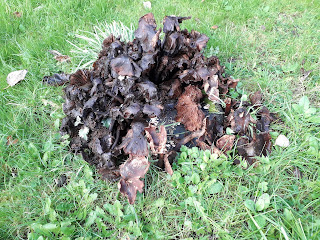Honey fungus fruiting bodies appear in the autumn and are killed off by the first frosts, but the fungus lives on in the roots of the affected tree. A serious infection as on the birch tree below will appear around the base of the trunk and on the ground over infected roots. It is the cambium of the roots that it attacks first, opening them up to decay.
The brackets start off as small honey-coloured button mushrooms, turning brown as they increase in size. The tell-tale signature is the ring or collar near the top of the stem, just visible in the photo below left on the top left individual. If you are worried you have honey fungus, look underneath the cap. If there are no rings on the toadstools it is not honey fungus.
The last four images show the degradation over time of the toadstools on an old
plum tree stump. Finishing as a black gooey mess.







No comments:
Post a Comment
I just love getting comments so go ahead.